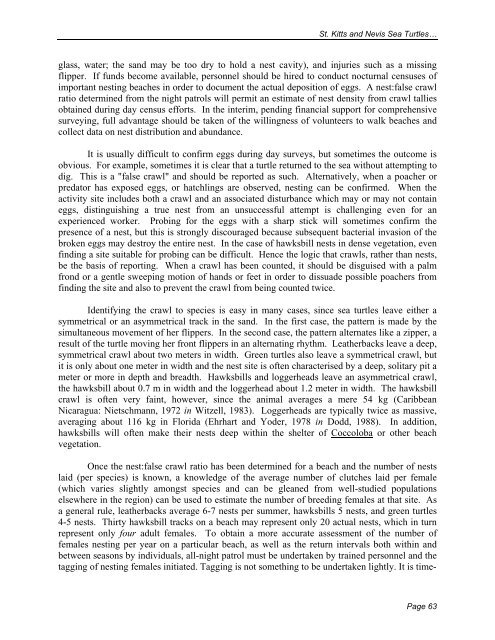Sea Turtle Recovery Action Plan for St. Kitts and Nevis - WIDECAST
Sea Turtle Recovery Action Plan for St. Kitts and Nevis - WIDECAST
Sea Turtle Recovery Action Plan for St. Kitts and Nevis - WIDECAST
Create successful ePaper yourself
Turn your PDF publications into a flip-book with our unique Google optimized e-Paper software.
<strong>St</strong>. <strong>Kitts</strong> <strong>and</strong> <strong>Nevis</strong> <strong>Sea</strong> <strong>Turtle</strong>s…<br />
glass, water; the s<strong>and</strong> may be too dry to hold a nest cavity), <strong>and</strong> injuries such as a missing<br />
flipper. If funds become available, personnel should be hired to conduct nocturnal censuses of<br />
important nesting beaches in order to document the actual deposition of eggs. A nest:false crawl<br />
ratio determined from the night patrols will permit an estimate of nest density from crawl tallies<br />
obtained during day census ef<strong>for</strong>ts. In the interim, pending financial support <strong>for</strong> comprehensive<br />
surveying, full advantage should be taken of the willingness of volunteers to walk beaches <strong>and</strong><br />
collect data on nest distribution <strong>and</strong> abundance.<br />
It is usually difficult to confirm eggs during day surveys, but sometimes the outcome is<br />
obvious. For example, sometimes it is clear that a turtle returned to the sea without attempting to<br />
dig. This is a "false crawl" <strong>and</strong> should be reported as such. Alternatively, when a poacher or<br />
predator has exposed eggs, or hatchlings are observed, nesting can be confirmed. When the<br />
activity site includes both a crawl <strong>and</strong> an associated disturbance which may or may not contain<br />
eggs, distinguishing a true nest from an unsuccessful attempt is challenging even <strong>for</strong> an<br />
experienced worker. Probing <strong>for</strong> the eggs with a sharp stick will sometimes confirm the<br />
presence of a nest, but this is strongly discouraged because subsequent bacterial invasion of the<br />
broken eggs may destroy the entire nest. In the case of hawksbill nests in dense vegetation, even<br />
finding a site suitable <strong>for</strong> probing can be difficult. Hence the logic that crawls, rather than nests,<br />
be the basis of reporting. When a crawl has been counted, it should be disguised with a palm<br />
frond or a gentle sweeping motion of h<strong>and</strong>s or feet in order to dissuade possible poachers from<br />
finding the site <strong>and</strong> also to prevent the crawl from being counted twice.<br />
Identifying the crawl to species is easy in many cases, since sea turtles leave either a<br />
symmetrical or an asymmetrical track in the s<strong>and</strong>. In the first case, the pattern is made by the<br />
simultaneous movement of her flippers. In the second case, the pattern alternates like a zipper, a<br />
result of the turtle moving her front flippers in an alternating rhythm. Leatherbacks leave a deep,<br />
symmetrical crawl about two meters in width. Green turtles also leave a symmetrical crawl, but<br />
it is only about one meter in width <strong>and</strong> the nest site is often characterised by a deep, solitary pit a<br />
meter or more in depth <strong>and</strong> breadth. Hawksbills <strong>and</strong> loggerheads leave an asymmetrical crawl,<br />
the hawksbill about 0.7 m in width <strong>and</strong> the loggerhead about 1.2 meter in width. The hawksbill<br />
crawl is often very faint, however, since the animal averages a mere 54 kg (Caribbean<br />
Nicaragua: Nietschmann, 1972 in Witzell, 1983). Loggerheads are typically twice as massive,<br />
averaging about 116 kg in Florida (Ehrhart <strong>and</strong> Yoder, 1978 in Dodd, 1988). In addition,<br />
hawksbills will often make their nests deep within the shelter of Coccoloba or other beach<br />
vegetation.<br />
Once the nest:false crawl ratio has been determined <strong>for</strong> a beach <strong>and</strong> the number of nests<br />
laid (per species) is known, a knowledge of the average number of clutches laid per female<br />
(which varies slightly amongst species <strong>and</strong> can be gleaned from well-studied populations<br />
elsewhere in the region) can be used to estimate the number of breeding females at that site. As<br />
a general rule, leatherbacks average 6-7 nests per summer, hawksbills 5 nests, <strong>and</strong> green turtles<br />
4-5 nests. Thirty hawksbill tracks on a beach may represent only 20 actual nests, which in turn<br />
represent only four adult females. To obtain a more accurate assessment of the number of<br />
females nesting per year on a particular beach, as well as the return intervals both within <strong>and</strong><br />
between seasons by individuals, all-night patrol must be undertaken by trained personnel <strong>and</strong> the<br />
tagging of nesting females initiated. Tagging is not something to be undertaken lightly. It is time-<br />
Page 63
















